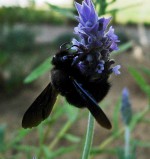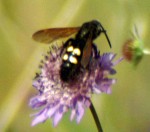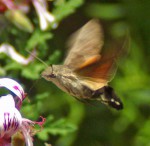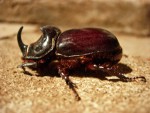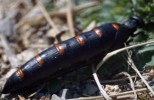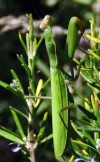9th April 2010
It was the strange movement of the bee-like insect that attracted my attention to this drama, which I initially thought was a honeybee in trouble. I didn’t see the attacking Crab Spider until I was very close; firstly it was very small and secondly, coloured almost white it was perfectly camouflaged against the petals of the Osteospermum flower.
This was the most amazing sight, and an even more amazing demonstration of the strength and determination of the little spider to get her prey off the flower and down onto the ground before something bigger came along and ate them both. I couldn’t see just how the spider was managing to move the bulk of her prey at all, as it clearly was unable to touch the petal’s surface with its feet. I think it managed to manoeuvre it to lie along the length of the petal, relying on its weight to then bend it, thus turning it into a slide and allowing the force of gravity to do the rest of the work. The strategy worked and the pair of them fell to the ground beneath.
CRAB SPIDER – FAMILY THOMISIDAE
As the name suggests, these spiders resemble small crabs and have short, wide, flattened bodies. The first two or three pairs of legs are longer than the rest and are normally held out from the sides of the body as a crab would hold its claws. Most are less than 1 cm (0.4 in) in length, although the giant crab spider may reach 2.5 cm (1.0 in).
Crab spiders do not spin webs to trap prey, but hunt on the open ground or on vegetation or flowers. Unlike other free-living spiders, however, all of a crab spider’s eyes are small and serve primarily as motion detectors. Typical crab spiders are predators that lie in wait to ambush their prey. Though their jaws, are rather small and slender, many crab spiders possess potent venoms that quickly immobilize their prey. Flower spiders, a particular type of crab spider, rest on flowers and remain motionless for long periods of time with their front two pairs of legs extended in readiness. They ambush butterflies, bees, flies, and other flower visitors; their venoms enable them to successfully attack insects much larger than themselves. They do not wrap their prey in silk after biting, but instead remain with the immobilized prey until they have sucked it dry.
In keeping with their ambush style of attack, many crab spiders are well camouflaged, blending in with their backgrounds. Some resemble tree bark, leaves, or fruits; others appear to mimic bird droppings. Some of the flower spiders are able to change their color over several days, typically between white and yellow, depending on the color of the flower on which they are resting.
Scientific classification: Common crab spiders are classified in the spider families Thomisidae and Philodromidae.






